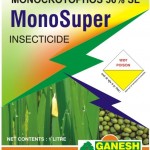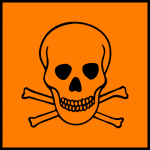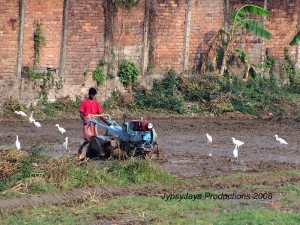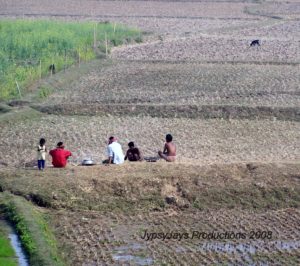Who is ultimately responsible for the school lunch deaths of twenty-three innocent children between the ages of 5 and 12 years old on the 16th of July, 2013 in the village of Gandamal in Bihar, India? Rightfully, investigations are in progress to discover how this meal became contaminated and who is responsible for the contamination. The bigger questions are who is manufacturing this toxic venom and who is allowing the sale and use of it? Those are people to be included as guilty of 23 counts of murder. Remember, we have successfully held the tobacco manufacturers responsible for tobacco related deaths. But let’s start with what was responsible for the untimely and unjust fatalities: Monocrotophos (mǒn-ō-krō-tō-fǒs)[i]. Monocrotophos is the highly toxic organophosphate pesticide responsible for their deaths. Organophosphates inhibit an enzyme necessary for nerves to work. They work as a pesticide by paralyzing the nervous system of insects we think of as pests. The trouble is they also work on the birds and the bees in the same way. On humans too. Symptoms of organophosphate poisoning in humans include nausea, vomiting, diarrhea, abdominal cramps, dizziness, blurred vision, excessive tearing, excessive salivation, sweating, confusion, incoordination, slurred speech, weakness, twitching, tremors, muscle spasms, involuntary urination and defecation, psychosis, irregular heart rhythms, seizures, coma, and as is evident by this horrific tragedy, even death. Monocrotophos is especially toxic; ingesting 120 mg, the weight of five to ten grains of rice, can be fatal. These poor kids were made to eat a meal laced with this poison.
Monocrotophos is the highly toxic organophosphate pesticide responsible for their deaths. Organophosphates inhibit an enzyme necessary for nerves to work. They work as a pesticide by paralyzing the nervous system of insects we think of as pests. The trouble is they also work on the birds and the bees in the same way. On humans too. Symptoms of organophosphate poisoning in humans include nausea, vomiting, diarrhea, abdominal cramps, dizziness, blurred vision, excessive tearing, excessive salivation, sweating, confusion, incoordination, slurred speech, weakness, twitching, tremors, muscle spasms, involuntary urination and defecation, psychosis, irregular heart rhythms, seizures, coma, and as is evident by this horrific tragedy, even death. Monocrotophos is especially toxic; ingesting 120 mg, the weight of five to ten grains of rice, can be fatal. These poor kids were made to eat a meal laced with this poison.
This neurotoxin, monocrotophos, was developed by Ciba- Geigy (now Novartis) in 1965. Novartis 
has now stopped making it. Let’s take a moment to name some other former and current manufacturers: Agrolinz, Inc. Bharat Pulverizing Mills Ltd. (India), Cia-Shen Co. Ltd. (China.), Comlets Chemical Industrial Co. Ltd. (R.O.C.), Cyanamid (Brasil), Hindustan Ciba Geigy ltd (India), Lupin (India), Nantong Pesticides Factory (China), Hui Kwang (China), National Organic Chemical Industries Ltd. (India), Quimica Estrella S.A.C.I.el (Argentina), Quingdao Pesticides Factory (China), Sudarshan (India), United Phosphorus (India), Sundat (S) Pte. Ltd. (Singapore), Novartis, DowElanco, NOCIL Ltd. (India). This list is not intended to be exhaustive.
The use of monocrotophos has been banned in 27 countries including the United States, the European Union, and Canada. The import of the insecticide is not allowed in 46 countries. The World Health Organization (WHO) and the Food and Agricultural Organization of the United Nations has been urging for a global phase out of this nerve poison. The Rotterdam Convention, an international treaty to ensure proper information disclosure about dangerous chemicals in the international  marketplace, has monocrotophos on their list of highly toxic substances. Keep in mind there are at least 70,000 synthetic chemicals in use today with about 1500 new substances joining the sludge each year. Of this stew of compounds there are only 43 chemicals on the Rotterdam Convention list and only 32 of them are pesticides. As an aside, asbestos still hasn’t made it on to the list. Clearly the list is not to be used as assurance about unlisted substances.
marketplace, has monocrotophos on their list of highly toxic substances. Keep in mind there are at least 70,000 synthetic chemicals in use today with about 1500 new substances joining the sludge each year. Of this stew of compounds there are only 43 chemicals on the Rotterdam Convention list and only 32 of them are pesticides. As an aside, asbestos still hasn’t made it on to the list. Clearly the list is not to be used as assurance about unlisted substances.
India not only has ignored recommendations by the WHO urging a ban on monocrotophos, it has gone ahead with becoming a major manufacturer of this toxic substance. There are at least 40 manufacturers of monocrotophos in India. It is a very common pesticide easily available in India. It is cheap. It is also one of the most common causes of accidental occupational poisonings. The WHO has said “Pesticides whose handling and application require the use of personal protective equipment that is uncomfortable, expensive or not readily available should be avoided, especially in the case of small-scale users in tropical climates.” Monocrotophos qualifies as this sort of pesticide and India qualifies as this sort of setting. India does not have a culture of safety or prevention. People think you are weird if you wear a seat belt in a car. You rarely see anyone wearing a bicycle helmet. Fat chance a poor farmer is going to spend  money on boots, protective clothing, gloves, masks, or a respirator. And even if he or she had the spare cash, there is no way in burning hell that he or she is going to wear that personal protective equipment while working in the fields under a sun that’s scorching the air to a barely tolerable 110°F/ 43°F. You try it. You wouldn’t last 5 minutes at rest in the shade, much less doing the arduous physical labor of agriculture by hand. Not only that, in India many people refer to agricultural chemicals as davai, medicine, that helps plants. Many of the farmers cannot read the labels on the containers and have not been properly informed about their dangers. Given the situation, it wouldn’t be surprising to find out cooking oil was being stored in an empty monocrotophos container at the ill-fated school.
money on boots, protective clothing, gloves, masks, or a respirator. And even if he or she had the spare cash, there is no way in burning hell that he or she is going to wear that personal protective equipment while working in the fields under a sun that’s scorching the air to a barely tolerable 110°F/ 43°F. You try it. You wouldn’t last 5 minutes at rest in the shade, much less doing the arduous physical labor of agriculture by hand. Not only that, in India many people refer to agricultural chemicals as davai, medicine, that helps plants. Many of the farmers cannot read the labels on the containers and have not been properly informed about their dangers. Given the situation, it wouldn’t be surprising to find out cooking oil was being stored in an empty monocrotophos container at the ill-fated school.
Monocrotophos is one of the main agents used in the current epidemic of farmer suicides. According to the National Crime Records Bureau in India, every year since about 2006 approximately 17,000-18,000 poor Indian farmers have been taking their own lives by ingesting an insecticide. Farmers are lured by the promises of higher yields through genetically modified seeds and chemically intensive farming methods. They despair under the weight of the debts incurred by the costs and the failed assurances. The lives of 23 innocent children have been sacrificed to bring the world’s attention to the scourge of death by pesticide ingestion in India, accidental or intentional. But life is cheap in India. There are so many people that the accidental deaths of 23, or more than 20,000 people (the current estimates for the cumulative death toll due to the 1984 Union Carbide Gas Disaster in Bhopal), doesn’t cause the government to take a strong stand or make a meaningful move. My guess is it is because most of the victims and survivors are poor.
 Nevertheless, according to a 2012 report by Research and Markets, India is emerging as the sixth largest producer of pesticides worldwide. India, the land that developed the ancient science of Ayurveda, the art of health and longevity through natural food and living, is now one of the top producers of poisons. The report actually laments that due to farmers’ financial inability to buy the “required” (quotations mine) pesticides, consumption of these chemicals per hectare in India is far below the global average. I guess this is one instance in which poverty could save your life. The Pesticides Manufacturers and Formulators’ Association of India (PMFAI) is up in arms about the European Union’s ban on endosulfan. They’ll likely do their best to make sure monocrotophos doesn’t get banned in India. The market within India itself is too large, even if the rest of the world is on the bandwagon to ban the stuff. The Indian domestic market itself is US$1.36 billion. PMFAI is also committed to promoting the export of pesticides of Indian origin. The president of PMFAI stated in an interview with Business Standard this week that since 1997 pesticide exports from India have gone from US$50 million to US$1.32 billion. The entire global market for pesticides is worth around US$ 44 billion and is projected to grow to US$65 billion in the next few years.
Nevertheless, according to a 2012 report by Research and Markets, India is emerging as the sixth largest producer of pesticides worldwide. India, the land that developed the ancient science of Ayurveda, the art of health and longevity through natural food and living, is now one of the top producers of poisons. The report actually laments that due to farmers’ financial inability to buy the “required” (quotations mine) pesticides, consumption of these chemicals per hectare in India is far below the global average. I guess this is one instance in which poverty could save your life. The Pesticides Manufacturers and Formulators’ Association of India (PMFAI) is up in arms about the European Union’s ban on endosulfan. They’ll likely do their best to make sure monocrotophos doesn’t get banned in India. The market within India itself is too large, even if the rest of the world is on the bandwagon to ban the stuff. The Indian domestic market itself is US$1.36 billion. PMFAI is also committed to promoting the export of pesticides of Indian origin. The president of PMFAI stated in an interview with Business Standard this week that since 1997 pesticide exports from India have gone from US$50 million to US$1.32 billion. The entire global market for pesticides is worth around US$ 44 billion and is projected to grow to US$65 billion in the next few years.
One must understand the strength of the Indian Pesticide Industry. Remember Bhopal. Over  twenty-thousand dead to date. With second generation neurodevelopmental injuries being suffered by the kids of the survivors. The committee responsible for issuing the license for Union Carbide to use the dangerously toxic chemical methylisocyanate in the manufacturing of a pesticide, carbaryl (trade name Sevin), had denied permission three times before it was finally granted. It has never been made clear why they changed their decision. The members of the committee who finally conceded to Union Carbide should be held responsible for their acts of commission and omission. The Central Insecticide Board of India was in charge of ensuring that safety standards are adhered to in the pesticide manufacturing plants in India, including the Union Carbide plant in Bhopal. The Board failed in regulating the plant and should be liable for criminal negligence for their role in the largest industrial disaster in history. The Government of India needs to get it together and act to protect its people from harm.
twenty-thousand dead to date. With second generation neurodevelopmental injuries being suffered by the kids of the survivors. The committee responsible for issuing the license for Union Carbide to use the dangerously toxic chemical methylisocyanate in the manufacturing of a pesticide, carbaryl (trade name Sevin), had denied permission three times before it was finally granted. It has never been made clear why they changed their decision. The members of the committee who finally conceded to Union Carbide should be held responsible for their acts of commission and omission. The Central Insecticide Board of India was in charge of ensuring that safety standards are adhered to in the pesticide manufacturing plants in India, including the Union Carbide plant in Bhopal. The Board failed in regulating the plant and should be liable for criminal negligence for their role in the largest industrial disaster in history. The Government of India needs to get it together and act to protect its people from harm.
 While the police and the media are pointing fingers at the head mistress of the school where these children ate their last meal, and harshly criticizing the invaluable school lunch program, let’s not forget the responsibility of the people making the murderous chemical agents, the government that allows its ubiquitous use, and our collective responsibility for allowing it all to take place right under our noses.
While the police and the media are pointing fingers at the head mistress of the school where these children ate their last meal, and harshly criticizing the invaluable school lunch program, let’s not forget the responsibility of the people making the murderous chemical agents, the government that allows its ubiquitous use, and our collective responsibility for allowing it all to take place right under our noses.
“..the person who for his own purpose brings on his lands and collects and keeps there anything likely to do mischief, if it escapes, must keep it in at his peril, and if he does not do so, is prima facie answerable for all the damage which is the natural consequence of its escape.” – Rylands vs. Fletcher, UK, July 17, 1868
[i] In case you were curious, or have difficulty pronouncing monocrotophos, there are various trade or brand names for this deadly chemical including Azodrin, Bilobran, Crotos, Crisodrin, Glore Phos36, Monocil 40, Monocron, More-Phos, Monocrotophos 60 WSC, Harcros Nuvacron, Nuvacron 600 SCW, Pillardrin, and Plantdrin, and Red Star Monocrotophos. These names aren’t necessarily any easier to say.
Note: A version of this article appeared as an Op-Ed piece in The Hindu on 10 Sep 2013.















Thank you for a very informative article about not only the deaths but the systemic causes of their deaths and the destruction of the lives of farmers and other people in India by the use of these pesticides.
Steve Zeltzer
Must read and very informative article. It connects many dots together and explains the underlying causes of disasters and health issues that we hear sometimes but donot hear many times because the bad results are not so dramatic. Great job. Keep up the good work.Thanks
I agree wholeheartedly with Abhijeet Singh. We must preserve and improve the school lunch program in India. The free mid-day meals have decreased protein and iron deficiencies and improved calorie intake. The attendance of girls has improved because of the meals. And the fact that children from all castes sit together to share food is revolutionary in a culture so highly stratified along these lines. Abhijeet offers the evidence for these benefits in this article.
http://www.guardian.co.uk/global-development/poverty-matters/2013/jul/19/indian-school-lunch-deaths-midday-meals
The culprit is not the free school lunch programs, but the fact that these dangerous pesticides are being used and mishandled when they should actually be banned.
I wasn’t aware about monochrotophos and by focusing on the pesticides aspect of the Bihar tragedy that’s a very insightful perspective; something I haven’t seen being discussed in the media. Thanks, Jayshree for writing a long one.
Thank you for appreciating the information and the viewpoint offered, Anuj. Most of the media coverage of this disaster has not focused on this aspect. I believe it is a very important contributing factor. If we address it appropriately countless other tragedies could be prevented. The free school lunch program benefits so many children. Even as the integrity and strength of that program must be maintained with regular inspections and accountability, we must also not let the manufacturers of these poisons off the hook. The same principle has been used with the tobacco industry with great success. The stores that sell tobacco are not held accountable for tobacco related deaths, but the manufacturers of tobacco products have been successfully sued for their role in the massive death toll due to tobacco. Maintain the school lunch program, ban dangerous and deadly pesticides.